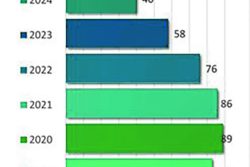If the countries of the Caribbean might have been holding their breath for news from the World Bank pointing to some measure of relief from what has been a protracted global food crisis, the Bank’s Monday, March 13 update provides little, if any, cause for comfort. Instead, it appeared to suggest that the crisis, having deepened in poor countries and poor communities in Asia, Africa and elsewhere, now also sits on the doorstep of “high-income” countries. Simultaneously, the Bank has sought to restate its earlier view that “almost all low and middle income countries” are now well and truly besieged with varying levels of high food prices.
In the Bank’s most recent report on the issue, it says that the countries now most affected by continually rising food prices are located in Africa, North America, Latin America, South Asia, Europe and Central Asia. Tellingly, in its most recent assessment of the state of global food insecurity, the World Bank asserts that on a year by year basis, the price of rice, a near global staple, is now 19% higher. Meanwhile, going forward the Agriculture Market Information System (AMIS) Market Monitor, the inter-agency platform established in 2011 by the G20 Ministers of Agriculture, has underscored the lingering uncertainty hanging over agricultural markets, given the unrelenting hostilities in the year-old Russia/Ukraine conflict. The World Bank notes that Ukraine being an integral part of the global food basket, its increasing preoccupation with fending off Russia now means that other countries will need to plant additional grains and oilseeds if global stocks are to be rebuilt and prices eased.
Here in the Caribbean, last year’s notification by the World Bank that parts of the region were being afflicted by a food security crisis, had closely coincided with the region’s ‘food alert’ which had been characterized by a commitment to reducing its extra-regional food imports by 25% by 2025 and an undertaking by Barbados and Guyana to spearhead the establishment of a Regional Food Security Terminal to which countries of the region could turn in circumstances of acute crisis. Responses included a regional commitment to replacing its imported foods by 25% by 2025, and as far as possible, replacing those with foods produced in the region. The extent of the prevailing global food crisis has, meanwhile, been further underscored by a review of the global food security circumstances, one year after Russia’s military invasion of Ukraine, by the Washi8ngton-based International Food Policy Research Institute (IFPRI) which continues to remain focused on the issue of food security in the near future.
The hostilities in Ukraine have jeopardized more than one-third of world wheat trade, 17% of world maize trade, and almost 75% of world sunflower trade, causing prices of wheat futures to jump almost 60% within a week of the war’s outbreak; corn and soybean prices were up more than 15%. Although the world faced the possibility of another food price crisis, the worst-case scenarios for agricultural trade and food security have, up until now, been largely averted, with prices falling back to pre-war levels by August 2022 because of efforts such as the partial re-opening of ports through the Black Sea Grain Initiative and an increase in global humanitarian efforts to mitigate the impacts of the war. Here in the Caribbean, where a real food security crisis remains an issue rather than a preoccupation with regional governments, the twin issues of increasing agricultural output and creating robust across-the-board systems to protect the most vulnerable countries would appear to be a key focus of the region’s efforts to keep a food security-related crisis from its doors.
Here, Guyana’s customarily robust rice industry is likely to be at the very centre of the Caribbean effort to stave off further food security scares. Beyond the Caribbean, the prognosis for short-term easing of the prevailing global food security challenges is not good. One of the more recent indicators of this is the Global Report on Food Crisis 2022 Mid-year Update which stated that, going forward, up to 205 million people were expected to face acute food insecurity and to be in need of urgent assistance in 45 countries. This, despite last year’s global response by the World Bank which centred around a move by the World Bank late last year to make up to US$30 billion available over a period of 15 months, including US$12 billion in new projects designed to “scale up short- and long-term responses along four themes to boost food and nutrition security, reduce risks, and strengthen food systems: (i) support producers and consumers, (ii) facilitate increased trade in food and trade inputs, (iii) support vulnerable households, and (iv) invest in sustainable food and nutrition security.”
If the Caribbean is by no means one of the global food insecurity basket cases identified in the various reports on global insecurity, its challenges are clear for all to see. Much will depend on the extent to which the current regional Food Terminal project proves to be a game-changer. Here, it should be noted that in previous years, Guyana, considered on account of its strong agricultural sector to be the food basket of the Caribbean, has been part of earlier failures in the pursuit of regional food security ambitions. This time around, the Caribbean as a whole may be comforted by the fact, that this time around, Guyana (along with Barbados) is going to be at the helm of the regional food security ship at a time when its new-found ‘oil wealth’ would appear to have better positioned it to lead the regional food security charge than it had previously been. Still, Guyana cannot be unaware of the fact that the assets needed for successfully undertaking the lead role in pursuit of the goal of regional food security, includes a clear vision and a capacity to lead by commitment and example.







